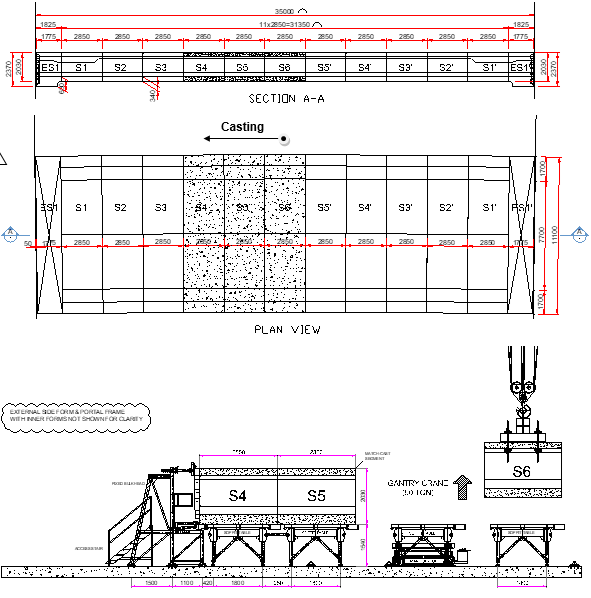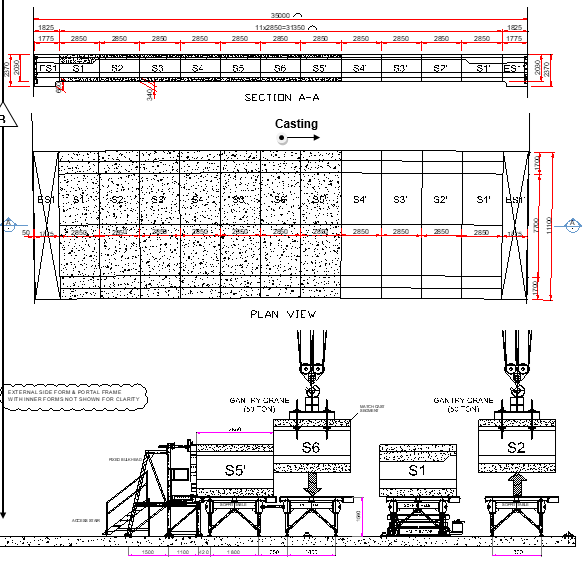Method Statement for Casting Sequence - Short Line Typical Segment
1. INTRODUCTION
1.1 PURPOSE OF THE DOCUMENT
The purpose of this procedure is to define the sequence of operations to be carried out casting typical segments using the short line casting method, and ensure that all works will be conducted safely in accordance with the drawings and the project specifications.
1.2 PROJECT DESCRIPTION
Ho Chi Minh City Urban Railway Construction Project – Ben Thanh – Suoi Tien section (Line 1), contract Package 2 consists of approximately 12 km long of elevated viaduct structures, erected by span-by-span Method.

1.3 SCOPE OF WORK
This procedure is developed for clarifying the casting sequence of typical segments for curved spans, produced with the short line casting method.
1.4 REFERENCES
All reference documents are intended to refer to the last issued revision.
Specifications
- Clause 12.4.1 “Precast segment casting” Section 12-3 of 19 from Outline construction specification – Package 2: Civil (Elevated & Depot)
- “Standard specifications for concrete structures – 2007, Materials and construction” from Japan Society of Civil Engineers, regarding the stripping strength (14 MPa) required to reach.
Method Statement
- HCMC-261-CSYD-CWS- 00012 “General precasting works at precasting yard”
- HCMC-261-CSYD-CWS- 00041 “Precast segment production – Short Line Typical mould”
1.5 DEFINITIONS
All relevant definitions have been given in Section 1.5 “Definitions” of the Method Statement “General precasting works at precasting yard” HCMC-261-CSYD-CWS- 00012 and “Precast segment production for Short Line Typical mould” HCMC-261-CSYD-CWS- 00041
2. SAFETY & ENVIRONMENTAL RISKS
All the Hazard Analysis & Risk Assessment, Tools & Equipment and Emergency response, regarding each task described in this procedure, such as: casting of segment, segment lifting, operations & preparations of the mould, etc. will be carried in each related method statement. Refer to Section 1.4 “References” for further details.
3. CONSTRUCTION RESOURCES
All the construction resources, such as personnel, plant & tools and materials regarding each task described in this procedure will be carried out in each related method statement.
4. SHORT LINE TYPICAL MOULD – SLT
4.1 DESCRIPTION
Listing of mould for the production of typical segments:
- Short Line Typical #1 (SLT #1)
- Short Line Typical #2 (SLT #2)
- Short Line Typical #3 (SLT #3)
4.2 COMPONENTS
Each Short Line Typical mould has the following components:

| Items | Quantity |
|---|---|
| 1. Soffit tables | 3 Nos |
| 2. Manipulator with 4 hydraulic vertical & horizontal jacks | 1 Nos |
| 3. External side forms (left & right) | 1 Set |
| 4. Inner forms (left & right) | 1 Set |
| 5. Portal frame for inner form (including the roof) | 1 Set |
| 6. Fixed bulkhead (with supports, Stairs & platforms) | 1 Nos |
| 7. Stop-End #2 (Stop-End used to cast the 1st segment) | 3 Nos for 9 formwork |
| 8. Hydraulic system (for inner forms) | 1 Set |


5. CONSTRUCTION SEQUENCE
5.1 INTRODUCTION
In the precasting yard, each span (straight or curved) is built by assembling differents segments of variable longitudinal lengths. More than 4,587 segments shall be manufactured by Match-Cast (M/C) principle with combination of short line and long line casting method.
Straight spans will be cast with the long line casting method, via the Long Line Typical mould (LLT), while curved spans will be achieved using the short line casting method via the Short Line Typical mould (SLT). Casting of pier segments for straight & curved spans will be achived on dedicated Short Line Pier mould (SLP), using the short line casting method. Segments are match-cast. It means that the previously segment, after being cast, is defined as counter mould segment (Match-Cast); the new segment will be cast against, ensuring a perfect and unique connection match-cast face.
After the concrete has been poured, and the stripping concrete strenght required reached, the elements of the mould shall be stripped and shifted. The M/C segment is shifted on the rail track by means of manipulator and maintained aside for the requested curing time, prior to be transferred to finishing area the day after. In the same time, the cast segment is also moved to the match-cast position, by means of manipulator; then a “free” space is created to start a new casting cycle.
5.2 MOULD OPERATION CYCLE FOR SHORT LINE TYPICAL SEGMENT
- Survey of as-built geometry.
- Remove inflatable tubes (also called “Satujo”) after stripping concrete strength required reached.
- Strip inner forms & shift portal frame on rail behinh the fixed bulkhead.
- In parallel, marking of segment (ID number, Span No, date of casting & arrow). Refer to the method statement “Segment marking” HCMC-261-CSYD-CWS-00022
- Strip & shift external side forms.
- In parallel, clean inner forms & soffit table and apply the mould release agent.
- Bond breaking between cast segment and Match-Cast (M/C) segment (or remove stop-end if no M/C segment).
- Detach cast segment from fixed bulkhead and relocate to M/C position.
- Apply the debonding agent to M/C segment joint surface.
- Lift and position the soffit table to cast position.
- Clean external side forms and apply the mould release agent.
- Position & pre-close the external side forms.
- Rebar cage is store next to the casting location, completed and equiped with corrugated PT duct and spacer blocks. Place the pre-checked rebar cage in the mould.
- Place and survey the M/C segment (or stop-end if no segment).
- Install inserts (CP3, temporary PT, lifting holes, etc..)
- SCC/GS inspection prior to formworks closure.
- Shift on rail the portal frame (with inner forms) to casting position.
- Final closing of inner forms & external side forms against fixed bulkhead and M/C segment (or stop-end if no segment).
- Final survey Refer to the method statement “Geometry control for short line casting method” HCMC-261-CSYD-CWS-MST-00016
- Infill completely “satujo”
- Final inspection before casting / Cleaning of workstation
- Cast short line typical segment & concrete finishing (floating) Refer to the method statement “Segment concreting works” HCMC-261-CSYD-CWS-MST-00020
- Cure segment Refer to the method statement “Curing of segments” HCMC-261-CSYD-CWS-MST-00021
- Transfer cured segment to finishing area, after lifting strength concrete required reached Refer to the method statement “Segment liftings & handling works” HCMC-261-CSYD-CWS-MST-00023
- Segment finishing works Refer to the method statement “Segment finishing works” HCMC-261-CSYD-CWS-MST-00024
- Remedial works for segment (if needed) Refer to the method statement “Segment remedial works” HCMC-261-CSYD-CWS-MST-00025
- Storage of segment Refer to the method statement “Segment storage and ½ stacking” HCMC-261-CSYD-CWS-MST-00026
Load segment on trailers for site delivery Refer to the method statement “Segment delivery and transportation” HCMC-261-CSYD-CWS-MST-00027 Note that all mould preparation and operations mentioned in this cycle will be described in the dedicated method statement “Precast segment production – Short Line Typical mould” HCMC-261-CSYD-CWS-MST- 00041.
Note that pier segments (“ES1” and “ES1’ “) are always cast at dedicated Short Line Pier Mould. Refer to the following method statements:
- HCMC-261-CSYD-CWS-MST- 00018 “Casting sequence for short line pier segment”
- HCMC-261-CSYD-CWS-MST- 00040 “Precast segment production - Short Line Pier mould”
5.3 CASTING SEQUENCE - SLT
For curved span N, the 1st segment to cast is from the middle of the span. For 35m span length, the 1st segment shall be segment “S6”.
- DAY 1:
- Cast 1st segment “S6” between fixed bulkhead and Stop-End #2

- DAY 2:
- Move segment “S6” to match-cast position
- Cast segment “S5” between fixed bulkhead and M/C segment “S6”

- DAY 3:
- Remove segment “S6” from the precasting bed
- Move segment “S5” to match-cast position
- Cast segment “S4” between fixed bulkhead and M/C segment “S5”

- DAY 4:
- Remove segment “S5” from the precasting bed
- Move segment “S4” to match-cast position
- Cast segment “S3” between fixed bulkhead and M/C segment “S4”

- DAY 5:
- Remove segment “S4” from the precasting bed
- Move segment “S3” to match-cast position
- Cast segment “S2” between fixed bulkhead and M/C segment “S3”

- DAY 6:
- Remove segment “S3” from the precasting bed
- Move segment “S2” to match-cast position
- Cast segment “S1” between fixed bulkhead and M/C segment “S2”

Once all segments (“S6, S5, S4, S3, S2 and S1”) of the first half of span N are cast, segment “S6” is moved back to the precasting bed to be used as match-cast to cast the second half of span N starting with segment S5’.
- DAY 7:
- Remove segment “S2” from the precasting bed
- Move segment “S1” to lifting position
- Cast segment “S5’ ” between fixed bulkhead and M/C segment “S6”

- DAY 8:
- Remove segment “S1” from the precasting bed
- Remove segment “S6” from the precasting bed
- Move segment “ S5’ “ to match-cast position
- Cast segment “ S4’ ” between fixed bulkhead and M/C segment “ S5’ ”

- DAY 9:
- Remove segment “ S5’ ” from the precasting bed
- Move segment “ S4’ ” to match-cast position
- Cast segment “ S3’ ” between fixed bulkhead and M/C segment “ S4’ ”

- DAY 10:
- Remove segment “ S4’ ” from the precasting bed
- Move segment “ S3’ ” to match-cast position
- Cast segment “ S2’ ” between fixed bulkhead and M/C segment “ S3’ ”

- DAY 11:
- Remove segment “ S3’ ” from the precasting bed
- Move segment “ S2’ ” to match-cast position
- Cast segment “ S1’ ” between fixed bulkhead and M/C segment “ S2’ ”

5.4 SEGMENT PRODUCTION - DAILY CYCLE
In the precasting yard, two concrete pumps will be used to cast simultaneously two segments per hour. As shown on the daily cycle, the first two segments shall be completed and ready to be cast at 2pm. Concreting operations shall be completed at 3pm.
Simultaneously, the next two segments shall be ready to be cast from 3pm to 4pm, etc.. and the casting cycle will be repeated until the last segments to be cast between 7pm and 8pm. The total duration per day to cast the eleven segments shall be 6hours, from 2pm to 8pm.
After concreting, each segment will be cure as required. For more details, refer to the method statement “Segment concreting works” HCMC-261-CSYD-CWS-MST- 00020 and “Segment curing” HCMC-261-CSYD-CWS-MST- 00021.
5.5 CONCLUSION
The Short Line Typical (SLT) mould, used to cast typical segments for curved spans, can manufacture 1 segment per day, in accordance with all safety and quality requirements.
6. ACTIVITY HOLD POINTS
Hold points will be identified in the Inspection & test Plan. Refer to the ITP for “Precast segment production”:
7. INSPECTION & RECORDS
All Inspection / check-lists & documents records will be identified in the Inspection & test Plan. Refer to the ITP for “Precast segment production”
